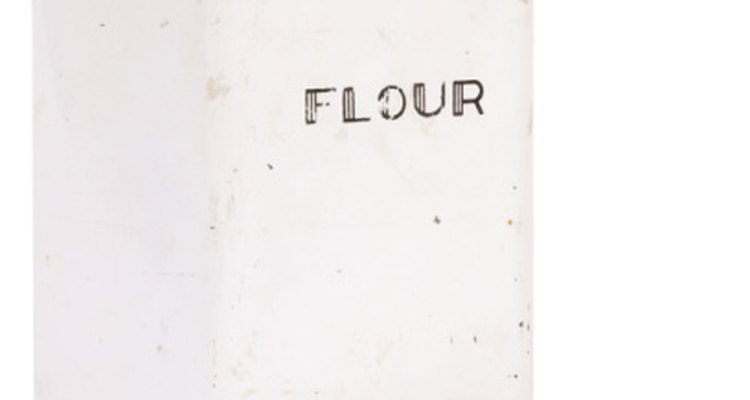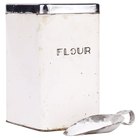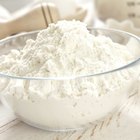
With so many different flours and sugars, storage guidelines vary slightly. Basic flours, such as all-purpose, cake, bread and pastry, have a longer shelf life and are not as likely to go rancid as whole-wheat flours and other heavier flours such as oat, rye and barley. Heavier flours require much cooler temperatures for storage. White and brown sugar last indefinitely, but only when stored properly, making adequate storage conditions just as important as with flour.
Basic Flours
Place the flour in an airtight container.
Mark the purchase date on the outside of the container with a permanent marker.
Store the container or bag in a dark, dry area that maintains temperatures below 75 degrees Fahrenheit. A pantry or basement space works well. The flour should keep for several months; freeze the flour for longer storage.
Heavy Flours
Place the flour in an airtight container.
Mark the processing date -- usually printed on the packaging -- on the outside of the container with a permanent marker.
Place the container in the freezer. Since these flours go rancid quickly, do not store them at room temperature.
White Sugar
Place the white sugar in an airtight container.
Mark the purchase date on the outside of the container with a permanent marker. While sugar has an indefinite shelf life, the longer it is stored, the more change you may notice in its flavor and freshness.
Place the container in a cool, dry, dark area, but not in the refrigerator. Keep the sugar away from areas of strong odors, such as around other strong smelling foods.
Brown Sugar
Place the bulk brown sugar in an airtight container in which it fits well. A lot of air space in the container may allow the sugar to harden.
Mark the purchase date on the outside of the container with a permanent marker. While brown sugar also has an indefinite shelf life, it's best to use it within six months for the best flavor.
Store the container in a cool, dark area.
Related Articles

Does Flour Expire?

Does Flour Spoil?

How to Defrost a Frozen Cake With ...

How to Store Clothes in Storage

How to Get Rid of Mold in a Gym Bag

What Will Happen if You Refrigerate ...

Does Flour Get Old or Go Bad?

How to Soften Leather Jackets
Methods of Long-Term Food Storage for ...

How Long After a Sell-By Date Can You ...
How Long Can Flour Be Stored in Mylar ...
Can You Freeze Granulated Sugar?
How to Keep Flour for Long-Term Storage

How to Keep Wedding Dresses From ...

How to Store Flour

Does it Help to Keep Flour in the ...

How to Keep Sugar From Clumping

Does Baking Soda Need to Be ...

How Long Does Banana Bread Stay Fresh?

How to Freeze Croissants
References
Tips
- Bring frozen flour back to room temperature before using.
Writer Bio
Sommer Leigh has produced home, garden, family and health content since 1997 for such nationally known publications as "Better Homes and Gardens," "Ladies' Home Journal," "Midwest Living," "Healthy Kids" and "American Baby." Leigh also owns a Web-consulting business and writes for several Internet publications. She has a Bachelor of Science in information technology and Web management from the University of Phoenix.
Photo Credits
Hemera Technologies/PhotoObjects.net/Getty Images